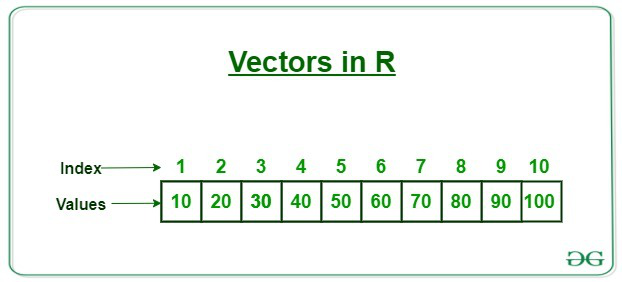Assigning Vectors in R Programming
Last Updated :
30 Jun, 2020
Vectors are one of the most basic data structure in R. They contain data of same type. Vectors in R is equivalent to arrays in other programming languages. In R, array is a vector of one or more dimensions and every single object created is stored in the form of a vector. The members of a vector are termed as components .

Assigning of Vectors
There are different ways of assigning vectors. In R, this task can be performed using c() or using “:” or using seq() function.
-
Assigning vector using c()
Generally, vectors in R are assigned using c() function.
Example 1:
V = c(1, 2, 4, 6, 7)
print(V)
print(typeof(V))
|
Output:
[1] 1 2 4 6 7
[1] "double"
Example 2:
V2 = c(1.5, TRUE, 4, "Geeks")
print(V2)
print(typeof(V2))
|
Output:
[1] "1.5" "TRUE" "4" "Geeks"
[1] "character"
-
Assigning a vector using “:”
In R, to create a vector of consecutive values “:” operator is used.
Example 1:
Output :
[1] 1 2 3 4 5 6 7 8 9 10
Example 2:
Output:
[1] 1.5 2.5 3.5 4.5 5.5 6.5 7.5 8.5 9.5
Example 3:
If there is a mismatch of intervals, it skips the last value.
Output:
[1] 1.5 2.5 3.5 4.5 5.5 6.5 7.5 8.5
-
Assigning Vectors with seq()
In order to create vectors having step size, R provides seq() function.
Example 1:
V = seq(1, 3, by=0.2)
print(V)
|
Output:
[1] 1.0 1.2 1.4 1.6 1.8 2.0 2.2 2.4 2.6 2.8 3.0
Example 2:
It’s possible to specify the required length of the vector and step size is computed automatically.
V = seq(1, 10, length.out=5)
print(V)
|
Output :
[1] 1.00 3.25 5.50 7.75 10.00
Assigning Named Vectors in R
It’s also possible to create named vectors in R such that every value has a name assigned with it. R provides the names() function in order to create named vectors.
Example:
Suppose one wants to create a named vector with the number of players in each sport. To do so, first, he will create a numeric vector containing the number of players. Now, he can use the names() function to assign the name of the sports to the number of players.
sports.players = c(2, 4, 5, 6, 7, 9, 11)
names(sports.players) = c("Bridge", "Polo", "Basketball",
"Volleyball", "kabaddi",
"Baseball", "Cricket")
print(sports.players)
|
Output:
Bridge Polo Basketball Volleyball kabaddi Baseball Cricket
2 4 5 6 7 9 11
In order to get a sport with a particular number of players:
print(names(sports.players[sports.players==9]))
print(names(sports.players[sports.players==1]))
|
Output:
"Baseball"
character(0)
Explanation:
Baseball has nine players so it displays Baseball as output. Since here there is no sport with one player in this named vector, no output is generated and it displays the output as the character(0).
Access elements of a vector
In R in order to access the elements of a vector, vector indexing could be performed.
Note: Please note that indexing in R begins from 1 and not 0.
Example 1:
V = seq(1, 40, by= 4)
print(V)
print(V[5])
|
Output:
[1] 1 5 9 13 17 21 25 29 33 37
[1] 17
Example 2:
V = seq(1, 40, by= 4)
print(V)
print(V[c(5,7)])
|
Output:
[1] 1 5 9 13 17 21 25 29 33 37
[1] 17 25
Share your thoughts in the comments
Please Login to comment...